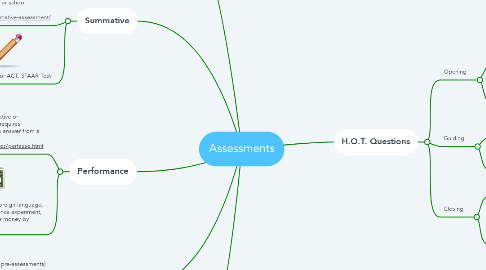
1. Formative
1.1. Formative assessment refers to a wide variety of methods that teachers use to conduct in-process evaluations of student comprehension, learning needs, and academic progress during a lesson, unit, or course. The general goal of formative assessment is to collect detailed information that can be used to improve instruction and student learning while it’s happening. Source: https://www.edglossary.org/formative-assessment/
1.2. Examples: Discussions, Exit Tickets
2. Interim/Benchmark
2.1. An interim assessment is a form of assessment that educators use to (1) evaluate where students are in their learning progress and (2) determine whether they are on track to performing well on future assessments, such as standardized tests or end-of-course exams. Source: https://www.edglossary.org/interim-assessment/
2.2. Examples: MAP Test, Benchmark Test
3. Summative
3.1. Summative assessments are used to evaluate student learning, skill acquisition, and academic achievement at the conclusion of a defined instructional period—typically at the end of a project, unit, course, semester, program, or school year. Source: https://www.edglossary.org/summative-assessment/
3.2. Examples: SAT or ACT, STAAR Test
4. Performance
4.1. Performance assessment, also known as alternative or authentic assessment, is a form of testing that requires students to perform a task rather than select an answer from a ready-made list. Source: https://www2.ed.gov/pubs/OR/ConsumerGuides/perfasse.html
4.2. Examples: Converse in a foreign language, conduct research for a science experiment, show you know how to use money by counting it and handling it
5. Diagnotic
5.1. Diagnostic assessments (also known as pre-assessments) provide instructors with information about student's prior knowledge and misconceptions before beginning a learning activity. Source: https://serc.carleton.edu/introgeo/assessment/formative.html
5.2. Examples: Pre-Tests, Placement Tests
6. H.O.T. Questions
6.1. Opening
6.1.1. Example 1: Recall what we read yesterday in chapter 10 of "A Dog Called Kitty."
6.1.2. Example 2: Describe how Ricky felt at the end of yesterday's chapter when Chuckie and Mama were able to do what he and Kitty were not able to do.
6.2. Guiding
6.2.1. Example 1: Predict whether or not you think we will see the wild dogs again. Explain your prediction to your table.
6.2.2. Example 2: Compare and contrast how Ricky acted toward dogs at the beginning of the book to how he acts toward dogs now.
6.3. Closing
6.3.1. Example 1: Summarize what just happened in chapter 11 to your shoulder partner.
6.3.2. Example 2: Put yourself in Ricky's shoes. In one paragraph, write how you would feel if your dad had just gone out of town and now it was on you to help your mom take care of all the farming chores.

